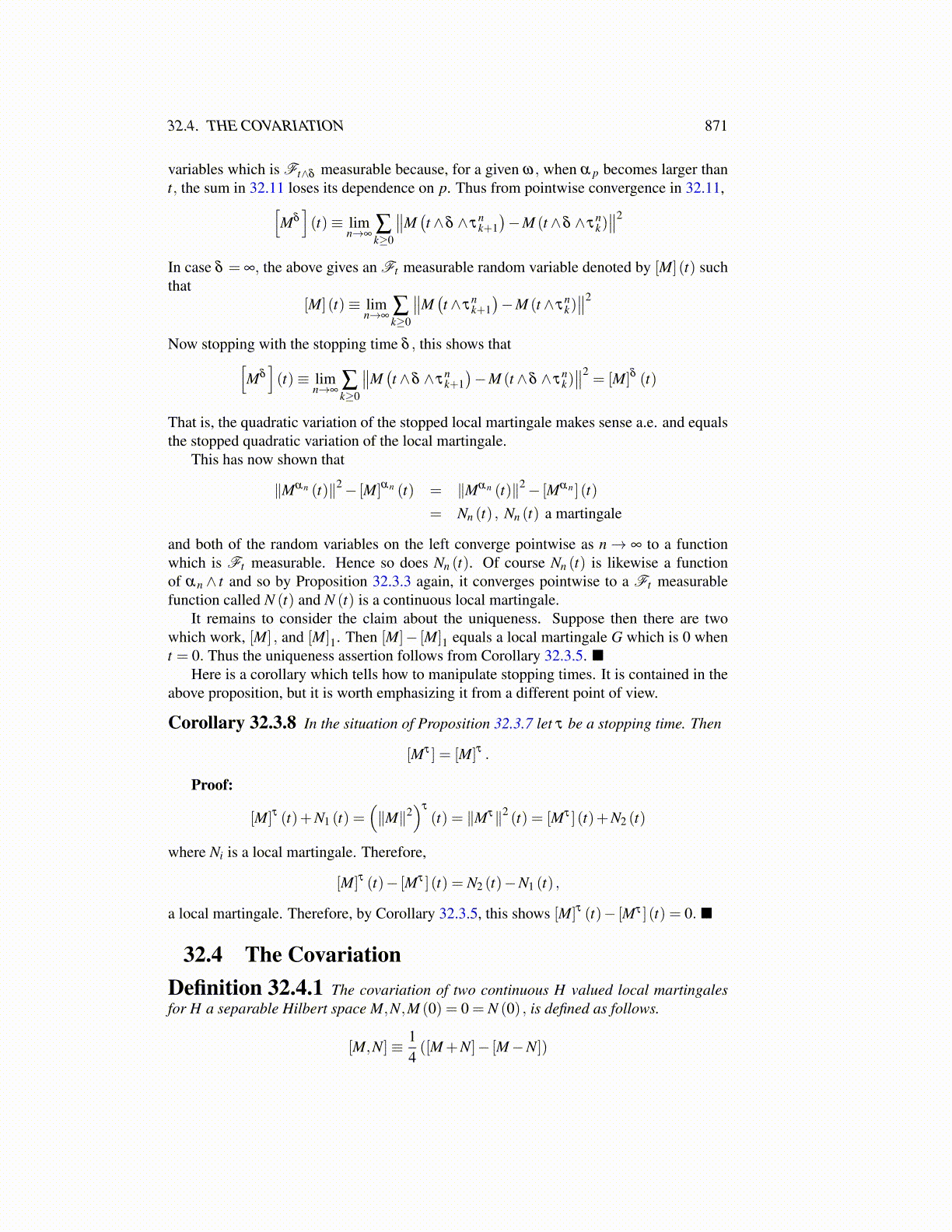
32.4. THE COVARIATION 871
variables which is Ft∧δ measurable because, for a given ω, when α p becomes larger thant, the sum in 32.11 loses its dependence on p. Thus from pointwise convergence in 32.11,[
Mδ
](t)≡ lim
n→∞∑k≥0
∥∥M(t ∧δ ∧ τ
nk+1)−M (t ∧δ ∧ τ
nk)∥∥2
In case δ = ∞, the above gives an Ft measurable random variable denoted by [M] (t) suchthat
[M] (t)≡ limn→∞
∑k≥0
∥∥M(t ∧ τ
nk+1)−M (t ∧ τ
nk)∥∥2
Now stopping with the stopping time δ , this shows that[Mδ
](t)≡ lim
n→∞∑k≥0
∥∥M(t ∧δ ∧ τ
nk+1)−M (t ∧δ ∧ τ
nk)∥∥2
= [M]δ (t)
That is, the quadratic variation of the stopped local martingale makes sense a.e. and equalsthe stopped quadratic variation of the local martingale.
This has now shown that
∥Mαn (t)∥2− [M]αn (t) = ∥Mαn (t)∥2− [Mαn ] (t)
= Nn (t) , Nn (t) a martingale
and both of the random variables on the left converge pointwise as n→ ∞ to a functionwhich is Ft measurable. Hence so does Nn (t). Of course Nn (t) is likewise a functionof αn ∧ t and so by Proposition 32.3.3 again, it converges pointwise to a Ft measurablefunction called N (t) and N (t) is a continuous local martingale.
It remains to consider the claim about the uniqueness. Suppose then there are twowhich work, [M] , and [M]1. Then [M]− [M]1 equals a local martingale G which is 0 whent = 0. Thus the uniqueness assertion follows from Corollary 32.3.5. ■
Here is a corollary which tells how to manipulate stopping times. It is contained in theabove proposition, but it is worth emphasizing it from a different point of view.
Corollary 32.3.8 In the situation of Proposition 32.3.7 let τ be a stopping time. Then
[Mτ ] = [M]τ .
Proof:
[M]τ (t)+N1 (t) =(∥M∥2
)τ
(t) = ∥Mτ∥2 (t) = [Mτ ] (t)+N2 (t)
where Ni is a local martingale. Therefore,
[M]τ (t)− [Mτ ] (t) = N2 (t)−N1 (t) ,
a local martingale. Therefore, by Corollary 32.3.5, this shows [M]τ (t)− [Mτ ] (t) = 0. ■
32.4 The CovariationDefinition 32.4.1 The covariation of two continuous H valued local martingalesfor H a separable Hilbert space M,N,M (0) = 0 = N (0) , is defined as follows.
[M,N]≡ 14([M+N]− [M−N])